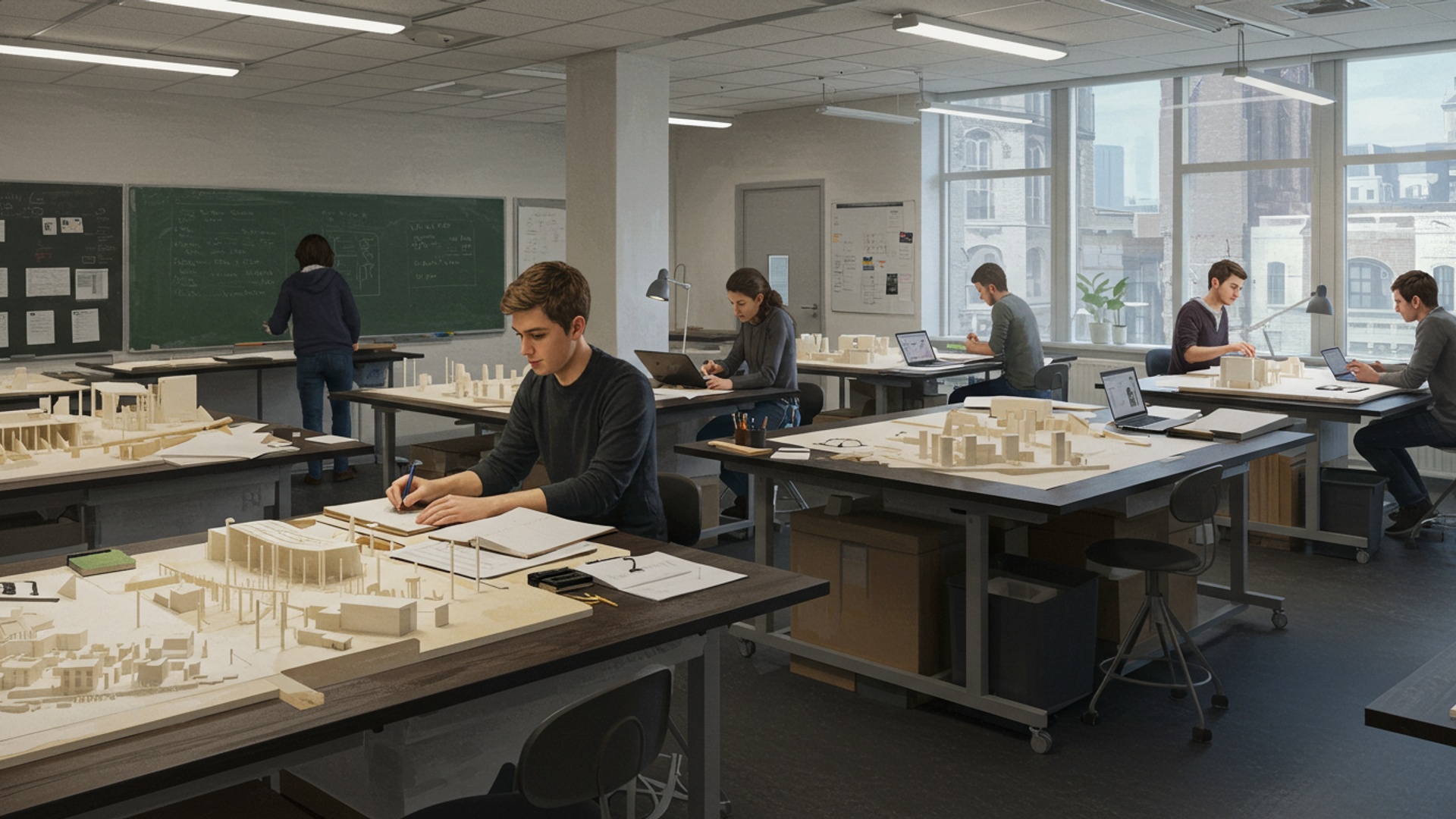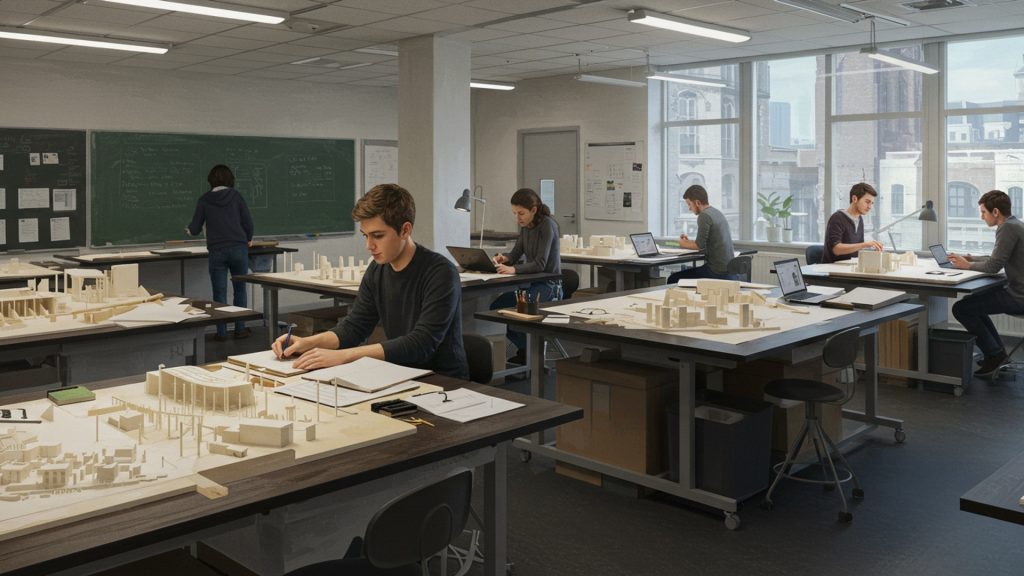Embarking on an architectural career in the UK offers unparalleled opportunities to shape the built environment, from reimagining historic urban fabrics to pioneering sustainable high-rises. The UK’s leading architecture programs, often R. I. B. A. accredited and globally renowned, are at the forefront of integrating innovative design methodologies like advanced digital fabrication and data-driven urbanism into their curricula. Aspiring architects seeking the top architecture universities UK wide will discover institutions actively engaged in addressing contemporary challenges, such such as net-zero carbon design and adaptive reuse strategies for our evolving cities. These programs equip students with a robust understanding of both aesthetic principles and technical complexities, preparing them for a dynamic profession demanding both creativity and responsible innovation.

Understanding Architecture Degrees in the UK: Your Foundation for Success
Embarking on a journey to become an architect in the UK is an exhilarating prospect. it all begins with selecting the right academic path. Unlike many other fields, architecture in the UK follows a distinctive, multi-stage accreditation process governed by the Architects Registration Board (ARB) and often aligned with the Royal Institute of British Architects (RIBA). Understanding this structure is paramount as you explore the top architecture universities UK has to offer.
The path to becoming a fully qualified architect typically involves three main stages, often referred to as ‘Parts’:
| Stage (Part) | Description | Typical Qualification | Duration |
|---|---|---|---|
| Part 1 | This is the foundational stage, providing a comprehensive understanding of architectural principles, history, theory, design. technology. It’s your first deep dive into the discipline, equipping you with essential skills. | BA (Hons) or BSc (Hons) in Architecture | 3-4 years (full-time) |
| Part 2 | Following Part 1 and typically a year of practical experience, Part 2 is an advanced academic stage. It delves deeper into complex design challenges, research. professional studies, fostering independent thought and critical analysis. | MArch (Master of Architecture) or Diploma in Architecture | 2 years (full-time) |
| Part 3 | The final stage, Part 3, focuses on professional practice, management. law. It combines further practical experience with rigorous examinations and case studies, leading to registration as an architect. | Postgraduate Certificate or Diploma in Architectural Practice | 1 year (part-time, alongside experience) |
It’s crucial that the program you choose is ‘ARB prescribed’ and ideally ‘RIBA validated’. An ARB prescribed course ensures your qualification is recognised for registration in the UK, while RIBA validation signifies adherence to high standards of architectural education, often opening doors internationally. Many of the top architecture universities UK proudly hold both accreditations, ensuring your future professional standing.
Why the UK is a Global Hub for Aspiring Architects
Choosing to study architecture in the UK is more than just selecting a university; it’s an immersion into a rich tapestry of architectural heritage, cutting-edge innovation. global influence. The UK offers a unique blend that makes it an exceptionally appealing destination for aspiring architects:
- A Legacy of Architectural Brilliance
- World-Renowned Academic Excellence
- Pioneering Innovation and Sustainability
- Strong Industry Connections
- Global Perspective
From the ancient wonders of Stonehenge to the gothic grandeur of Westminster Abbey, the elegant Georgian terraces of Bath. the futuristic skylines of London, the UK is a living museum of architectural styles. Studying here means direct access to unparalleled case studies and inspiration right on your doorstep.
UK universities consistently rank among the best globally. their architecture departments are no exception. They are celebrated for their rigorous curricula, innovative teaching methodologies. a strong emphasis on critical thinking and creative problem-solving.
The UK is at the forefront of sustainable design, smart cities. technological advancements in construction. You’ll engage with cutting-edge research, explore new materials. learn about designing for a greener future, preparing you for the evolving demands of the profession.
Many UK architecture programs boast robust links with leading architectural practices, engineering firms. urban planning agencies. This translates into invaluable opportunities for internships, guest lectures from industry leaders. networking events that can significantly boost your career prospects.
Studying in the UK exposes you to a diverse cohort of international students and faculty, enriching your learning experience and fostering a global outlook on architectural challenges and solutions. This multicultural environment is invaluable for a profession that increasingly operates across borders.
The dynamic interplay of history and innovation, coupled with a commitment to professional excellence, firmly establishes the UK as a premier choice for architectural education. The top architecture universities UK are not just institutions; they are vibrant ecosystems where future shapers of our built environment are nurtured.
Key Factors in Choosing Your Ideal Architecture Program
With an array of exceptional institutions, identifying the perfect fit among the top architecture universities UK can feel like a monumental task. To navigate this exciting decision, consider the following critical factors that will shape your educational journey and future career:
- Accreditation and Professional Recognition
- Program Specialisms and Research Focus
- Design Philosophy and Pedagogy
- Facilities and Resources
- Faculty Expertise and Industry Links
- Location and Environment
- Student Support and Community
As discussed, ensure the program is ARB prescribed and ideally RIBA validated. This is non-negotiable for professional practice in the UK and enhances international recognition.
Do you have a passion for sustainable design, urban planning, conservation, digital fabrication, or perhaps community architecture? Many universities have distinct research strengths and specialisms that permeate their curriculum. For instance, some might excel in experimental design, while others focus on historical preservation. Align your interests with the faculty’s expertise.
Each school has its unique design philosophy. Some are highly conceptual and theoretical, others more practical and technical. Explore their student portfolios, attend open days. read about their teaching approach. Do they emphasise hand drawing, digital modelling, or physical model making?
World-class architecture programs require state-of-the-art facilities. Look for well-equipped design studios, workshops (for wood, metal, ceramics, digital fabrication), computer labs with industry-standard software (e. g. , AutoCAD, Revit, SketchUp, Rhino, V-Ray, Grasshopper), extensive libraries. dedicated exhibition spaces. Access to these resources is vital for bringing your designs to life.
Research the faculty members. Are they practicing architects, leading researchers, or influential theorists? Their experience and connections can provide invaluable mentorship and opportunities. Strong industry links often lead to valuable internships and real-world project collaborations.
Consider the campus location. Do you prefer a vibrant city, a historic town, or a more rural setting? The surrounding built environment can be a constant source of inspiration and learning. Proximity to architectural practices or major construction sites can also be a bonus.
A supportive learning environment is crucial. Investigate the level of academic and pastoral support, career services. the vibrancy of student societies. A strong sense of community can significantly enhance your university experience.
By meticulously evaluating these aspects, you can refine your choices and identify the program that truly resonates with your aspirations and learning style.
Spotlight on Leading Institutions: Your Path to the Top Architecture Universities UK
While definitive rankings can shift and personal preferences vary, certain institutions consistently stand out for their excellence in architectural education. These top architecture universities UK are renowned for their innovative curricula, esteemed faculty. the exceptional talent they cultivate. Here’s a glimpse into some of these prominent choices, highlighting their unique strengths:
- University College London (UCL) – The Bartlett School of Architecture
- University of Cambridge
- University of Bath
- Manchester School of Architecture (MSA – a joint venture between the University of Manchester and Manchester Metropolitan University)
- Architectural Association School of Architecture (AA)
Consistently ranked among the world’s best, The Bartlett is globally recognised for its experimental and research-led approach to architecture. It’s famous for pushing boundaries in design, technology. urbanism, fostering a highly innovative and critical environment. Students benefit from its central London location, offering unparalleled access to architectural practices and a diverse urban fabric for study. Alumni often become leaders in avant-garde design and architectural theory. For example, the school’s focus on digital fabrication and computational design has led to groundbreaking student projects that rethink traditional construction methods.
Renowned for its rigorous academic tradition and emphasis on critical thinking, Cambridge offers a highly intellectual approach to architecture. The program integrates historical studies, theory. design with a strong focus on sustainability and material understanding. Its unique collegiate system provides a close-knit community feel. students often engage with conservation projects given the city’s rich heritage. The Department of Architecture here encourages a deep engagement with the theoretical underpinnings of the discipline.
Celebrated for its strong emphasis on technology, environmental design. professional practice, Bath’s architecture program is highly respected for producing graduates who are technically proficient and industry-ready. Its integrated Master of Architecture (MArch) program often includes a year in practice, providing invaluable real-world experience. The university’s research into low-carbon building and energy-efficient design makes it a leader in sustainable architecture education.
MSA is one of the largest and most established architecture schools in the UK. It offers a diverse range of specialisms, from urbanism to landscape architecture. is known for its strong community engagement and focus on the practical application of design. Its location in a dynamic, evolving city provides a living laboratory for urban studies. MSA frequently collaborates with local practices on live projects, giving students hands-on experience in community-led design.
The AA is a unique, independent school famous for its radical and experimental approach to architectural education. It operates on a unit system, allowing students to choose from a wide array of highly specialised design units each year, fostering extreme creativity and individual expression. It’s an intense, challenging. incredibly rewarding environment for those seeking an alternative, avant-garde path in architecture. The AA’s influence on global architectural discourse is immense, with many world-renowned architects having passed through its doors.
This is by no means an exhaustive list. these institutions exemplify the quality and diversity available within the top architecture universities UK. Each offers a distinct learning environment, so prospective students are strongly encouraged to research individual course structures, visit open days. speak with current students or alumni to find the best fit for their ambitions.
Navigating the Application Process and Crafting a Winning Portfolio
Securing a place at one of the top architecture universities UK requires meticulous preparation, especially when it comes to your application and, crucially, your portfolio. This is your chance to showcase your potential, creativity. passion for the built environment.
The Application Form (UCAS)
Most undergraduate applications in the UK are processed through UCAS (Universities and Colleges Admissions Service). Key components include:
- Personal Statement
- Academic References
- Predicted Grades
This is your opportunity to articulate why you want to study architecture, what excites you about the field. why you believe you’d be a good fit for their program. Showcase your passion, relevant experiences (e. g. , work experience, art classes, design competitions). future aspirations. Be authentic and enthusiastic!
You’ll need a strong reference from a teacher or advisor who can speak to your academic abilities, work ethic. suitability for higher education in architecture.
Ensure your predicted grades meet or exceed the entry requirements for your chosen courses.
The Power of Your Portfolio
Your portfolio is arguably the most critical component of your application to an architecture program. It’s not just a collection of drawings; it’s a visual narrative of your creative thinking, observational skills. potential as a designer. Admissions tutors want to see your unique perspective and passion.
Here’s what makes a strong portfolio:
- Showcase Your Creativity and Observation
- Highlight Your Process, Not Just the Product
- Variety of Media and Techniques
- Architectural Awareness (Optional but Recommended)
- Curate and Refine
Include a diverse range of work that demonstrates your ability to observe the world around you, think creatively. express ideas visually. This could include drawings, paintings, sculptures, photography, graphic design. even craft projects.
Don’t just show finished pieces. Include sketches, models, failed experiments. annotated notes that illustrate your thought process, how you develop ideas. how you solve problems. This reveals your potential for growth and learning.
Demonstrate proficiency in both traditional (hand drawing, watercolour, model making) and, if applicable, digital media. Show your ability to represent space, form, light. texture.
While you’re not expected to be an architect already, showing an interest in buildings, urban spaces, or architectural concepts can be beneficial. This could be through sketches of buildings, analyses of spaces, or projects inspired by architectural principles.
Be selective. Include only your best work, ensuring high-quality scans or photographs. Arrange your work logically, perhaps with brief explanations for each piece. A portfolio should tell a cohesive story about you.
Many universities offer portfolio advice sessions or workshops during open days – take advantage of these opportunities! Remember, your portfolio is a reflection of your unique voice and potential, so let it shine.
Life as an Architecture Student: Challenges, Rewards. Growth
Stepping into an architecture program at one of the top architecture universities UK is an immersive experience unlike many other degrees. It’s a journey of intense creativity, critical thinking. often, long hours. But the rewards are immense, shaping you into a resilient, innovative. highly skilled individual.
The Studio Culture: Your Second Home
The core of an architecture degree is the design studio. This is where you’ll spend countless hours, often late into the night, developing projects, collaborating with peers. receiving critiques (called ‘crits’ or ‘reviews’) from tutors and visiting professionals. The studio becomes a vibrant, collaborative hub, fostering a strong sense of camaraderie and shared purpose. It’s a place for experimentation, failure. ultimately, breakthrough.
Project-Based Learning
Unlike traditional essay-based degrees, architecture learning is predominantly project-based. You’ll be given design briefs, ranging from small-scale interventions to complex urban masterplans. tasked with developing innovative solutions. This hands-on approach builds practical skills alongside theoretical knowledge.
Developing Essential Skills
Beyond design, an architecture degree hones a vast array of transferable skills:
- Problem-Solving
- Critical Thinking
- Visual Communication
- Presentation Skills
- Time Management
- Resilience
Tackling complex design challenges requires creative and logical solutions.
Analyzing existing structures, understanding user needs. evaluating your own work.
Mastering various drawing techniques, model making. digital presentation.
Articulating your ideas clearly and persuasively during critiques.
Juggling multiple projects and deadlines.
Learning from critiques and adapting your approach.
A former student from a leading UK architecture school shared, “The studio was demanding. it taught me more than just design. It taught me how to think, how to articulate my ideas under pressure. how to embrace feedback. It was a transformative experience.”
Embracing the Journey
While the workload can be substantial, the passion for design and the support of your peers and tutors make it incredibly rewarding. You’ll witness your ideas transform from sketches into tangible models and detailed drawings, gaining a profound understanding of how the built environment impacts lives. It’s a unique educational path that equips you not just with a degree. with a distinctive way of seeing and shaping the world.
Unlocking Your Future: Career Pathways After an Architecture Degree
Completing your architectural education at one of the top architecture universities UK opens doors to an incredibly diverse and impactful range of career pathways, extending far beyond the traditional role of a ‘building designer’. While many graduates do pursue the path to becoming a fully qualified architect, the skills you acquire are highly transferable and sought after across numerous industries.
Becoming a Registered Architect
This is the most common and direct path. After completing your Part 1 and Part 2 qualifications, you’ll undertake a period of professional practical experience (typically 24 months). This experience is logged and provides real-world application of your academic learning. Finally, you’ll sit your Part 3 examination, which assesses your knowledge of practice management, contract administration. architectural law. Upon successful completion, you can register with the ARB and use the title ‘architect’.
Registered architects work in various settings:
- Private Architectural Practices
- Government and Public Sector
- In-House Architectural Teams
From small, boutique studios specializing in residential projects to large, international firms designing skyscrapers and urban masterplans.
Working for local councils, housing authorities, or heritage bodies on public buildings, urban regeneration, or conservation.
Large corporations, retailers, or developers often have their own architectural departments.
Beyond Traditional Architectural Practice
The comprehensive skillset developed during an architecture degree – including spatial reasoning, problem-solving, visual communication, project management. critical thinking – makes graduates highly adaptable for a multitude of other exciting careers:
- Urban Designer/Planner
- Interior Designer
- Landscape Architect
- Construction Project Manager
- Architectural Technologist
- Sustainability Consultant
- Set Designer (Film/Theatre)
- Graphic Designer/Visualizer
- Property Developer
- Academic/Researcher
Shaping the future of cities, focusing on public spaces, infrastructure. community development.
Specializing in the design and arrangement of interior spaces, often with a focus on functionality, aesthetics. user experience.
Designing outdoor spaces, from parks and gardens to large-scale ecological systems.
Overseeing the planning, execution. completion of construction projects, ensuring they are delivered on time and within budget.
Bridging the gap between design and construction, focusing on technical detailing, building regulations. construction methods.
Advising on environmentally friendly design and construction practices, energy efficiency. sustainable materials.
Creating immersive environments for productions, requiring strong spatial awareness and visual storytelling.
Utilizing advanced digital skills learned in architecture for creating compelling visual content, animations, or virtual reality experiences.
Identifying development opportunities, managing projects. bringing new buildings to fruition.
Pursuing further study and contributing to architectural theory, history, or innovative design research.
A recent graduate who transitioned into urban planning noted, “My architecture degree gave me an invaluable understanding of how cities function and how design impacts human experience. It was the perfect foundation for a career in urban development, even though I didn’t become a practicing architect.”
Your degree from a top architecture universities UK equips you not just with a qualification. with a highly versatile and creative toolkit, preparing you to shape the world in countless exciting ways.
Conclusion
As you embark on your journey to study UK architecture, remember that this isn’t merely about selecting a university; it’s about choosing a design philosophy that resonates with your aspirations. Beyond glossy brochures, delve into each program’s studio culture, examining recent student projects—particularly those addressing urban regeneration or sustainable materials, like the evolving use of cross-laminated timber (CLT) in London’s contemporary builds. My personal tip: visit open days, or at least attend virtual tours. speak directly to current students; their unfiltered experiences are invaluable. Ask about their favorite modules, or how the program integrates current trends like parametric design or Building data Modelling (BIM) for intricate projects. Ultimately, your portfolio will be your most potent voice. Start sketching daily, observing the built environment around you. experimenting with different media. Don’t be afraid to make mistakes; they’re often the most profound lessons in design. The UK architectural landscape is dynamic, constantly adapting to climate change imperatives and technological advancements, offering a fertile ground for future innovators. Embrace this challenge, for your unique perspective is precisely what the world of architecture needs. Go forth and design the future.
More Articles
Your Guide to Architecture Programs in the UK: Choosing the Right University
Navigating German Engineering Colleges: A Comprehensive Guide for International Students
Download GATE Previous Year Question Papers with Solutions PDF for Practice
Exploring Lucrative Biotechnology Careers: Your Guide to High-Demand Roles
FAQs
What’s the main idea behind this guide to UK architecture programs?
This guide is designed to help you navigate the many excellent architecture programs available in the UK. We break down what makes certain universities stand out and what you should look for to find the perfect course for your aspirations, ensuring you make an informed choice.
Why should I consider studying architecture in the UK?
The UK boasts some of the world’s most prestigious architecture schools, known for their innovative teaching, rich historical context. strong industry links. A UK qualification is globally recognised, opening doors to diverse career opportunities worldwide.
What key things should I consider when picking an architecture program?
When choosing, think about the program’s accreditation (like ARB/RIBA validation), the teaching approach (is it studio-focused or more theoretical?) , the facilities available, the university’s location. any specific specialisms like sustainable design or urban planning that might interest you.
Are there different kinds of architecture degrees available?
Yes, becoming a fully qualified architect in the UK typically involves a three-part process. You usually start with a Part 1 degree (like a BA or BSc), then a Part 2 (often an MArch), followed by a period of professional experience and a Part 3 qualification.
What’s the general process for applying to these programs?
Applications for undergraduate courses usually go through UCAS. You’ll need strong academic grades, often a compelling personal statement. usually a portfolio showcasing your creative abilities and interest in architecture. Some universities might also invite you for an interview.
Which universities are typically seen as the best for architecture in the UK?
While ‘best’ can be subjective and depend on your personal fit, institutions like the Bartlett (UCL), University of Cambridge, University of Bath, Manchester School of Architecture. Sheffield School of Architecture are consistently highly regarded for their excellence in teaching and research.
What kind of jobs can I get after completing an architecture degree in the UK?
Beyond becoming a licensed architect, a UK architecture degree opens up a wide array of career paths. You could work in urban planning, landscape architecture, interior design, heritage conservation, set design for film or theatre, project management, or even architectural journalism.



